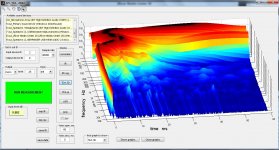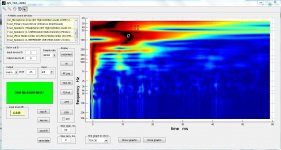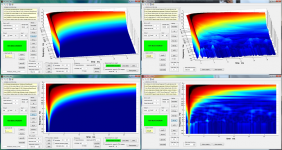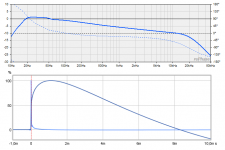Happy New year all!
Wesayso, been doing some research for you....
What about a pair of these:
TIW 300 - 8 Ohm
MMS 92g
BL 16.5
Nice FR.....
Compared to 30W/XXLS here is king of Mms at 113,91 grams, cost is 238€.
EDIT No seems above TIW 300 takes that Mms crown : )
bms 12s305 : 95g mms, voicoil height 32mm vs 33mm 30w, gap 10mm vs 8mm 30w. Carbon fiber cone, triple demodulation ring, 8ohm but only 0,7 inductance. Qts of 0,26. Cast aluminium chassis, vented gap and vented voicecoil... 180€ here. Exist in 4ohm.
Thanks for the help in this search! Much appreciated. That Visaton sure looks promising in a few ways. I was viewing the specs of the 10" version only yesterday as JonBocani mentioned it in one of his wild rampages. I remember thinking I should look up the 12" version.
That Peerless (Vifa origin if you ask me) does not make the cut though. The blimp in the impedance and a dip at exactly that spot could have more than one cause but it makes it "under suspicion". Is it inherent in the driver or only during that test (baffle related or something else). Anyway, I do look for that clean impedance plot, but did not miss something similar, only less benign in the 30W. Which means to look for third party impedance and frequency curves to know if it's the driver or the measurement. Still need to do the same with the XXLS. But this driver from Vifa pedigree has more than one setback and we do have to make choices somewhere.
I did not look up the BMS yet, but I will. Thanks for the recommendation.
I guess some simulations are in my near future (again).
One more thing about multi subs. More is always better, even if the differences are small. As long as it's not upsetting the overall response it will make each separate driver have to work a little less hard. That's always a good thing. Especially if it also brings new ways to counter reflective surfaces and other room anomalies. As long as everything still lines up of course.
Sadly, 2 will have to do for the time being, no larger than 12". I would have loved to be able to do 15" or 18" even, less cone travel there. Cone area will help in getting the sound to be effortless, dynamic. At least in my distorted view 😛.
Last edited:
I like to learn as well and I try to keep an open mind. The science behind the multi-sub approach seems valid to me regardless of WHO said what or who did the research.
The Welti paper showed that 4 subs produced less output down low than 2 subs given the same power. I used to think that more is better, but it may not be so. Isn't that good news? Less expensive and less complicated.
Welti also suggested using the same signal for all subs, i.e., one EQ for the bass response. This was not what I was doing, but again it makes sense to me so I will change my approach. I am not afraid to change my views and I thought I would post it here to see what you and others thought. I won't be doing that again.
The Welti paper showed that 4 subs produced less output down low than 2 subs given the same power. I used to think that more is better, but it may not be so. Isn't that good news? Less expensive and less complicated.
Welti also suggested using the same signal for all subs, i.e., one EQ for the bass response. This was not what I was doing, but again it makes sense to me so I will change my approach. I am not afraid to change my views and I thought I would post it here to see what you and others thought. I won't be doing that again.
By no means did I mean to offend your contribution. But do think about it. When would adding more subs with the same amount of power result in less output? I can only think of one logical explanation: when they don't sum in phase.
The proposed theory might be fine, but I want to sum in phase instead. Sure the room dominates in these lower registers. I just want to fight my way trough that by making them actually sum in phase. Why? Because that way I will overcome more of the room signature. Making the signature embedded into the recording more free to be heard.
The who said who etc, was pointed out by me to keep a perspective of the goals from each proposal. If I want to make my room sound larger than life, I just have to battle with it.
If I swamp it, it will be more equalised too, but spread out in time. Yes you can EQ it as a total, but they won't add as favourably as they probably could.
If a live band were playing in my room it could sound really horrible. The room modes would dominate, same with putting speakers into the room un-equalized in that bottom end.
Spreading out the low end energy, swamping it with low end can even out that response. At the cost of the timing (which a lot of folks don't seem to mind) My proposal is to keep the timing by mainly using the usable parts of their respective response to combine it in a timely manor. This stuff we can test at the listening spot.
If it's worth it? I think it has a shot to try. Maybe I'm the one fighting windmills here. Though battling with my arrays did teach me something. Something I think will be useful for adding more headroom into that bottom end while trying to preserve the timing. It may still end up in a disaster. There is that chance.
Without trying I will never know. I've proven to myself that timing is important in that very bottom end. Most notably because I could actually sense it if it fired too early on some records. If it is on time and supports the mid frequencies it's a very powerful and clear sound.
To me, part of the fun is in trying these type of things. If I'm wrong, I will still learn from it and can divert back to the proposed way of things like the articles you linked too.
Don't stop on my account, like I said, I'm stubborn and pig-headed but I do listen. I just need to bump my head myself to really learn or accept stuff like this. There's way to much grey area in audio as is. I hope you'll reconsider, because by contributions like yours I start to think a little harder, trying to come up with answers to the questions in my mind by letting what you say in, I may sound blunt in response, but that's not intentional. I'm just reacting to it while letting it sink in. In other words, I appreciate your contributions.
One more thing to ask, if you EQ it like proposed in that paper, could you run the demo APL_TDA at the listening spot? That would make it a marvellous learning tool for all of us. At least I think so.
The proposed theory might be fine, but I want to sum in phase instead. Sure the room dominates in these lower registers. I just want to fight my way trough that by making them actually sum in phase. Why? Because that way I will overcome more of the room signature. Making the signature embedded into the recording more free to be heard.
The who said who etc, was pointed out by me to keep a perspective of the goals from each proposal. If I want to make my room sound larger than life, I just have to battle with it.
If I swamp it, it will be more equalised too, but spread out in time. Yes you can EQ it as a total, but they won't add as favourably as they probably could.
If a live band were playing in my room it could sound really horrible. The room modes would dominate, same with putting speakers into the room un-equalized in that bottom end.
Spreading out the low end energy, swamping it with low end can even out that response. At the cost of the timing (which a lot of folks don't seem to mind) My proposal is to keep the timing by mainly using the usable parts of their respective response to combine it in a timely manor. This stuff we can test at the listening spot.
If it's worth it? I think it has a shot to try. Maybe I'm the one fighting windmills here. Though battling with my arrays did teach me something. Something I think will be useful for adding more headroom into that bottom end while trying to preserve the timing. It may still end up in a disaster. There is that chance.
Without trying I will never know. I've proven to myself that timing is important in that very bottom end. Most notably because I could actually sense it if it fired too early on some records. If it is on time and supports the mid frequencies it's a very powerful and clear sound.
To me, part of the fun is in trying these type of things. If I'm wrong, I will still learn from it and can divert back to the proposed way of things like the articles you linked too.
Don't stop on my account, like I said, I'm stubborn and pig-headed but I do listen. I just need to bump my head myself to really learn or accept stuff like this. There's way to much grey area in audio as is. I hope you'll reconsider, because by contributions like yours I start to think a little harder, trying to come up with answers to the questions in my mind by letting what you say in, I may sound blunt in response, but that's not intentional. I'm just reacting to it while letting it sink in. In other words, I appreciate your contributions.
One more thing to ask, if you EQ it like proposed in that paper, could you run the demo APL_TDA at the listening spot? That would make it a marvellous learning tool for all of us. At least I think so.
Last edited:
Ron,
Keep it up. I tend to agree with you and not Geddes on the phase alignment and a clean impulse response. This has all been an old argument for so long with what was originally noted as time alignment, a very contentious subject among the smartest in the pro industry. I can imagine that you may smooth out some room modes by multiple subs at the same time I would expect that many places in the room would appear as nulls due to those same room modes. I tend to think that having all the sounds coming from the same direction with the best phase alignment would give the most natural sound field and get you closer to that they are here sound you are looking for.
Keep it up. I tend to agree with you and not Geddes on the phase alignment and a clean impulse response. This has all been an old argument for so long with what was originally noted as time alignment, a very contentious subject among the smartest in the pro industry. I can imagine that you may smooth out some room modes by multiple subs at the same time I would expect that many places in the room would appear as nulls due to those same room modes. I tend to think that having all the sounds coming from the same direction with the best phase alignment would give the most natural sound field and get you closer to that they are here sound you are looking for.
Guys, you might want to check out Optimize Multiple Subwoofers: Multi-Sub Optimizer Software
Similar results to Welti's SFM and free.
Similar results to Welti's SFM and free.
I'll take a look at it later on...
Is Geddes software tool still up? It was pretty cool too. It let you play with placement and height of subs out in the room. It was a bit tricky to get it to run. Seems like ages ago when I played with that.
Is Geddes software tool still up? It was pretty cool too. It let you play with placement and height of subs out in the room. It was a bit tricky to get it to run. Seems like ages ago when I played with that.
Wow, thanks pnix! I looked for Welti's SFM but couldn't find it. I think I searched for "SFX" not "SFM" 😱
@wesayso, I tried installing APL but I can't get the Matlab compiler to work.
@wesayso, I tried installing APL but I can't get the Matlab compiler to work.
@wesayso, I tried installing APL but I can't get the Matlab compiler to work.
That's a bummer, we should be able to rectify that somehow. What are you running O.S. wise, we should have a few readers here that tried it. I can't really remember what it took for me. BYRTT, you there?
.....BYRTT, you there?
Right here 😀
In past with these three files i got APL_TDA demo up running:
Those are 64bit version but i also hold a 32bit version of Matlab and if ra7 like i can share via OneDrive.
Attachments
Last edited:
I have a 64-bit Win7 laptop. Have the same files as Brytt. I tried it once and gave up. Maybe just need more time to troubleshoot. Did you have to do anything special, Brytt?
...Did you have to do anything special, Brytt?
Not other than right clicks and pick "Run as Administrator" for MatLab installation and same goes everytime i start APL_TDA.
Ok, I think I had the latest version of MCR that APL does not like. Downloading the older version now.
Guys, you might want to check out Optimize Multiple Subwoofers: Multi-Sub Optimizer Software
Similar results to Welti's SFM and free.
Thanks sharing (like button
 )
)The multi-sub thing is interesting, and I understand how it can smooth out the response.
But I am on record as not liking it, because it confuses the shape of the recording to my ears. The idea of getting them properly time aligned and EQ'd is interesting, and I'd love to hear more about the outcome. Perhaps some blind tests with different corrections.
I am convinced that people hear bass differently. Many are not sensitive to its direction, but some are. I've done a number of tests of this and found that there is a wide variance in bass location abilities. With more money and resources, I'd love to do more testing. IMO, if you cannot locate bass, you're not going to be bothered by distributed subs.
Interesting work going on here!
But I am on record as not liking it, because it confuses the shape of the recording to my ears. The idea of getting them properly time aligned and EQ'd is interesting, and I'd love to hear more about the outcome. Perhaps some blind tests with different corrections.
I am convinced that people hear bass differently. Many are not sensitive to its direction, but some are. I've done a number of tests of this and found that there is a wide variance in bass location abilities. With more money and resources, I'd love to do more testing. IMO, if you cannot locate bass, you're not going to be bothered by distributed subs.
Interesting work going on here!
Pano,
the question to me is are those who are able to detect direction of low bass actually cuing in on the higher harmonics of those frequencies or do they really have that ability? Most studies show below let's say 60hz you can't tell direction. Of course this is a different discussion to the one about getting the timing and phase correct to match the rest of the system.
the question to me is are those who are able to detect direction of low bass actually cuing in on the higher harmonics of those frequencies or do they really have that ability? Most studies show below let's say 60hz you can't tell direction. Of course this is a different discussion to the one about getting the timing and phase correct to match the rest of the system.
I don't want to drag that subject out into this thread, it's been covered well elsewhere.
FWIW, it's not an either/or answer.
FWIW, it's not an either/or answer.
Hey, this APL TDA software is pretty nice and simple to use. Here is my plot in 2D. Not bad, though not as nice as yours. This week I changed my sub positions to the wall midpoints and I'm trying the Welti approach of the same signal to both subs. I'm not using FIR correction anymore, just a 48 db/oct crossover in JRiver for both subs, which is what is causing the phase warp between 50-100 Hz. Another complication is one of my subs is a tapped sub, so, it has its own delay, and the other one is sealed.
But still not bad considering there is just one piece of EQ (a 10 db peak at 25 Hz in JRiver) and everything below 100 Hz is more or less within 10 ms. One wavelength at 100 Hz is 10 ms. And it takes a few cycles for our brain to decipher what frequency it is. With a bit of work in Rephase or maybe DRC, I can get that nice and smooth, though I'm not sure it will be audible. It sounds quite good as it is. And by good, I mean foot-tapping and wanting to get up and dance good.
But still not bad considering there is just one piece of EQ (a 10 db peak at 25 Hz in JRiver) and everything below 100 Hz is more or less within 10 ms. One wavelength at 100 Hz is 10 ms. And it takes a few cycles for our brain to decipher what frequency it is. With a bit of work in Rephase or maybe DRC, I can get that nice and smooth, though I'm not sure it will be audible. It sounds quite good as it is. And by good, I mean foot-tapping and wanting to get up and dance good.
Attachments
That's not bad ra7 thanks sharing so we can learn about these great TC9 arrays 🙂 though guess there will be some better slams in the the horizon working bit with that low end and XO.
Ronald's before DSP (post 2971) and yours side by side:

Think Ronalds system study and DSP execution is crazy good quality work, example here is a clean 96kHz IR-wav file created in Rephase traced over his stereo set at listening position:
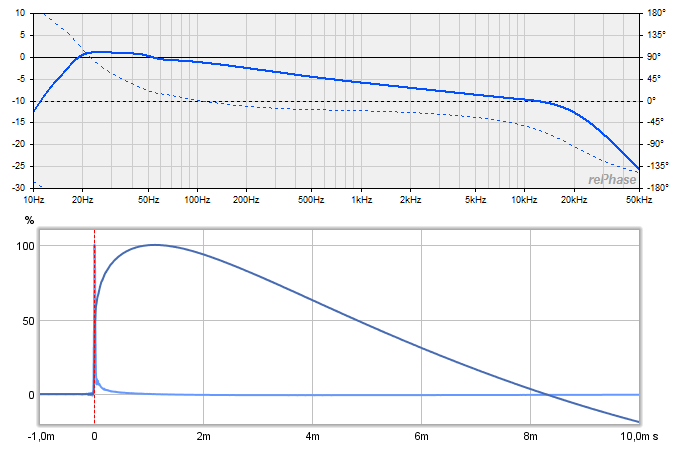
Here is how that IR-wav file looks in APL_TDA verse real world acoustics:
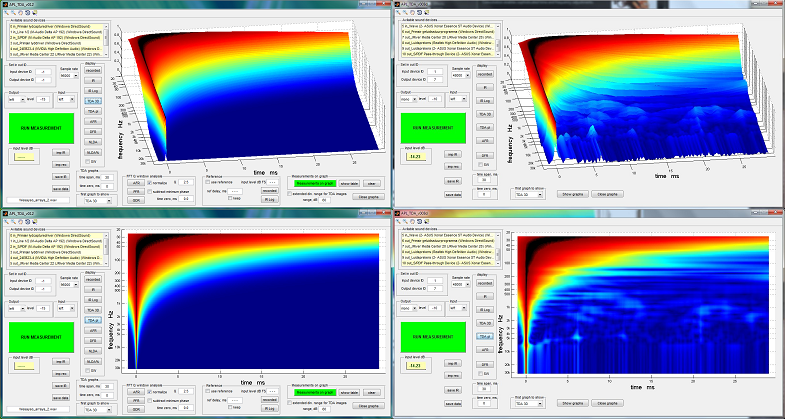
Ronald's before DSP (post 2971) and yours side by side:
Think Ronalds system study and DSP execution is crazy good quality work, example here is a clean 96kHz IR-wav file created in Rephase traced over his stereo set at listening position:
Here is how that IR-wav file looks in APL_TDA verse real world acoustics:
Attachments
EDIT: Another thing I forgot to mention in the earlier plots was that the mains correction might not hold for lower frequencies because I shifted my couch forward by a foot and half and hadn't yet developed a new DRC correction for it.
Thanks Brytt! Wesayso's measurements are insane. Not sure how someone can get that response in room. Amazing work, and probably lots of work there.
I get pretty good slam, and that was my point really. In the bass, flat and smooth = good timing. Peaky response = sluggish bass. And of course, no bass = fast bass. Timing does not come into it. We have to remember that just because we can measure an improvement does not mean it is audible. Now, Wesayso claims he can hear it, but we need more evidence, yes?
I would be curious to see what the APL graph looks like 12 inches to either side. The room is so dominant in the low bass that the more you correct one position, the worse it becomes in other locations.
I'll try to work on improving my response and see if I can hear it. It would be cool if there really is an audible difference.
BTW, the APL software is not stable on my machine. Sometimes, I get identical results on consecutive sweeps, sometimes it is garbage. I don't know how much we should rely on it for accuracy.
Thanks Brytt! Wesayso's measurements are insane. Not sure how someone can get that response in room. Amazing work, and probably lots of work there.
I get pretty good slam, and that was my point really. In the bass, flat and smooth = good timing. Peaky response = sluggish bass. And of course, no bass = fast bass. Timing does not come into it. We have to remember that just because we can measure an improvement does not mean it is audible. Now, Wesayso claims he can hear it, but we need more evidence, yes?
I would be curious to see what the APL graph looks like 12 inches to either side. The room is so dominant in the low bass that the more you correct one position, the worse it becomes in other locations.
I'll try to work on improving my response and see if I can hear it. It would be cool if there really is an audible difference.
BTW, the APL software is not stable on my machine. Sometimes, I get identical results on consecutive sweeps, sometimes it is garbage. I don't know how much we should rely on it for accuracy.
Last edited:
- Home
- Loudspeakers
- Full Range
- The making of: The Two Towers (a 25 driver Full Range line array)

